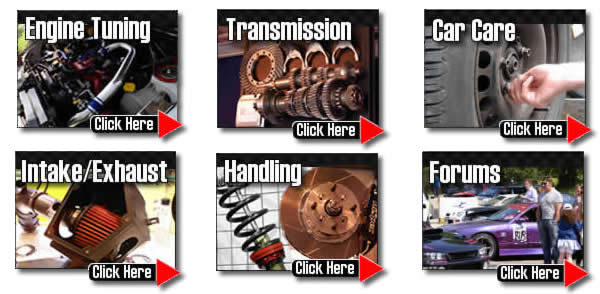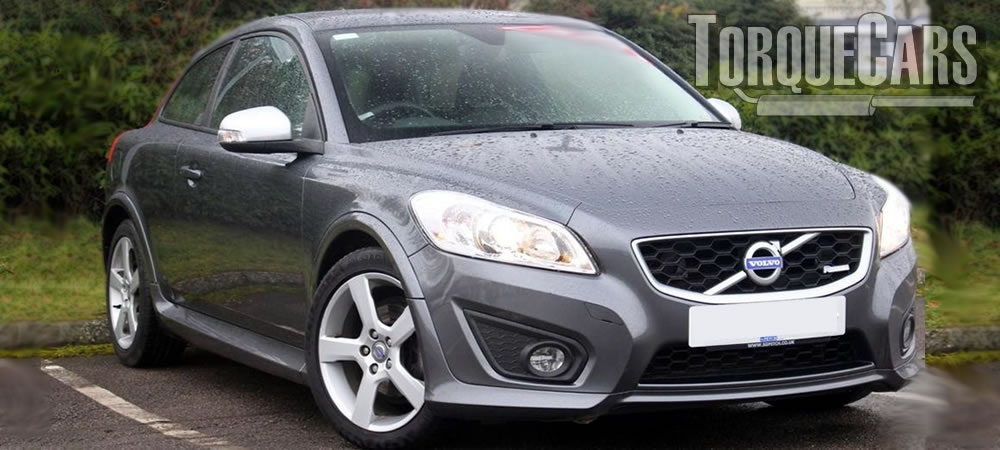Tuning the Volvo C30
"Thanks for reading our Volvo C30 tuning guide."
The C30 is a brilliant car modification project to take up your weekends.
Keep an eye out for the T5 turbo, it's one of our favorite C30 engine options, and offers a lot of reward when tuned.
But in reality all of the engines are solid and respond well to tuning, even the diesel engines.
If you do your homework then you can create an awesome C30 but don't be fooled there are lots of competition inspired mods out there that will simply not suit it read our unbiased guides first.

Handling/Suspension upgrades
Improving the handling for many people first priority in your C30 tuning project.
If you set the toe out to degrees on the front, and add some negative camber then cornering will radically benefit.
We suggest that you fit performance suspension and lower the car by 22mm - 35 mm. Larger drops require arch work - especially on models already equipped with performance suspension.
Turning our attention to the C30's engine we need to get a bit more power out of the top end.
Sadly with smaller engine sizes you are wasting your time spending money on modifications, so if this applies to you get yourself an engine swap then apply the following mods.
Tuning modifications.
These mods uprated kits are usually fitted by our members, decide how far you wish to go in your tuning project before you get started.
- 1.6 2006–2013 1,596 cc 1.6 L; I4, B4164S3 100 PS 74 kW; 99 hp @6000 150 N⋅m 111 lb⋅ft @4000
- 1.8 2006–2009 1,798 cc 1.8 L; I4, B4184S11 125 PS 92 kW; 123 hp @6000 165 N⋅m 122 lb⋅ft @4000
- 2.0 2006–2013 1,999 cc 2.0 L; I4, B4204S3 145 PS 107 kW; 143 hp @6000 185 N⋅m 136 lb⋅ft @4500
- 2.4i 2006–2013 2,435 cc 2.4 L; I5, B5244S4 170 PS 125 kW; 168 hp @6000 230 N⋅m 170 lb⋅ft @4400
- T5
- 2006–2007 2,521 cc 2.5 L; I5 turbo, B5254T3 220 PS 162 kW; 217 hp 320 N⋅m 236 lb⋅ft @1500–4800
2007–2013 - 2,521 cc 2.5 L; I5 turbo, B5254T7 230 PS 169 kW; 227 hp @5000 320 N⋅m 236 lb⋅ft @1500–5000
- Polestar Limited Edition 2012–2013 2,521 cc I5 turbo, B5254T7 253 PS 186 kW; 250 hp @5500 370 N⋅m 273 lb⋅ft @3000
Diesel engines - 1.6D, 1.6D DRIVe 1,560 cc 1.6 L; 95.2 cu in i4 turbo, D4164T 109 PS 80 kW; 108 hp @4000 240 N⋅m 177 lb⋅ft @1750
- D2 2010–2013 1,560 cc 95 cu in i4 turbo 115 PS 85 kW; 113 hp @3600 270 N⋅m 199 lb⋅ft @1750-2500
- 2.0D 1,997 cc 2.0 L; 121.9 cu in i4 turbo, D4204T 136 PS 100 kW; 134 hp @4000 320 N⋅m 236 lb⋅ft @2000
- D3 2010–2013 1,984 cc 121 cu in I5 turbo, D5204T5 150 PS 110 kW; 148 hp @3500 350 N⋅m 258 lb⋅ft @1500-2750
- D4 2010–2013 1,984 cc 121 cu in I5 turbo, D5204T 177 PS 130 kW; 175 hp @3500 400 N⋅m 295 lb⋅ft @1750-2750
- D5 automatic 2,401 cc 2.4 L; 146.5 cu in I5 turbo, D5244T8 180 PS 132 kW; 178 hp @4000 350 N⋅m 258 lb⋅ft @1750–3250
- D5 manual 2,401 cc 2.4 L; 146.5 cu in I5 turbo, D5244T13 180 PS 132 kW; 178 hp @4000 400 N⋅m 295 lb⋅ft @2000–2750
Getting the right modified modifications for your planned usage of the car is vital. Stage 3 (competition) mods just won't work well on the road hard to control in slow traffic.
Please watch our introduction Video tutorial to car tuning. Be sure to subscribe and support our new channel.
How to tune your car
- Improve the handling
Focus on Suspension improvements, such as coilovers and make sure the bushings are in good order and that the alignment is correct. Then focus on improving the brakes, with a big disk brake conversion kit and fast road brake pads.
- Remove restrictions
Focus on the intake and exhaust with filters being the common point of restriction in a tuned car. Intercoolers may also become restrictive on turbo engines so this may also need to be uprated.
- Burn more fuel & air
Increase the fuelling so it matches the air coming into the engine. The ratio is important so you need to improve the fuel pump and injectors, so the head mods, big valve conversions, fast road camshafts and forced induction upgrades extra supply of air is adequately met.
- Test and replace any weak parts
Weak areas are commonly the clutch, the turbocharger and pistons and crankshaft in a highly tuned engine. Makes sure these components will cope with your power aspirations.
- The Tune or Remap
A cars ECU controls the fuel, timing, spark and even the turbo in some cases, so to fully extract your gains you should remap the car last and this will fully release the power. Some cars are easy to map, and others require piggyback ECU's or aftermarket ECU's but this is the most vital step of your tuning project.
Modifying to Stage 1:
Suspension upgrade (drop 22mm - 35 mm.), Lighter flywheel, Panel air filter, Remap, Alloy wheels, Sports exhaust.
Modifying to Stage 2:
Ported and polished head, Fast road cam, fuel pump upgrades, Power/Sport clutch, high flow fuel injector.
Modifying to Stage 3:
Internal engine upgrades (pistons/head/valves), Sports gearbox, Engine balancing, Adding or upgrading forced induction (turbo/supercharger), Competition cam.

Your targets when modding your car should be a wide torque output. You don't want all the power to be at the top end of the rev range unless you are creating a motor sport car.
The whole point of our pointers is to give a little insight into the world of tuning mods and point you in the right direction, our forum is best place to go if you need more detailed advice and tips on your tuning project, the best motorsport mods and all aspects of modding cars.One of the biggest mechanical modifications you can do to your NASP engine is to fit a fast road cam .
The exhaust & intake valve durations play a big role in your cars power band, but be careful here, getting this wrong can upset the idle and make the car hard to drive in traffic. You'd need to follow a camshaft upgrade with other mods and finish with a remap to fully realise your gains.
Don't forget to pay attention to the fuelling when you are increasing the power - it makes the car more thirsty.
Using high octane petrol is another option if you find you are suffering from pinking or premature ignition on your Volvo project after fitting other tuning modifications. To get sufficient fuel you may need to uprate the injectors on your engine.
A fuel pump will only deliver a finite amount of fuel, so you may need to uprate this if your injectors are demanding more fuel.
Intake and Exhaust Tuning.
Breathing mods are usually next up. Air induction kits are only beneficial to boost performance if the cars air intake is restricted!
Adding an induction kit to most stock engines will see ZERO LOW END POWER GAIN AT ALL. If you have heavily modified your engine and it's need for air INCREASES DRAMATICALLY then an induction kit is the answer and will help remove this restriction.
Derestricting the airflow into the engine is a primary goal of car tuners so get a freer flowing air filter if you find that the car is running lean only if you find the car is running lean.
Induction kits can sound fun but due to the warm air in the engine bay they will not add noticeable power and actually rob you of power.
Sports exhausts can help balance the flow of gases through the engine. But if the exhaust is too big, ie: it's over 2.5 inches bore, you will lose much of the flow rate and end up sapping power and torque.
Head work including a polish and port and 3 or 5 angle valve job will really help to release the potential of the engine. In nearly all cases of C30 tuning your clutch will start to complain and this should be improved - read our article on clutches for more information.
The best mods in our opinion for your C30 are fast road camshaft, remap, induction and exhaust, suspension.
Turbo engines are just crying out to be Remapped.
You will see large power gains on most modern turbocharged cars including diesels making a remap one of the most cost effective and large modifications for your money.
Adding forced induction will see significant power gains but this is usually too expensive to be cost effective. Superchargers are often easier to add than a turbo. It is difficult to map fuelling with a turbo as the boost builds exponentially with revs.
Hybrid turbos work well but you'll usually have to upgrade the air flow meter and fuelling to get the full upgrade from your new turbo.
The nice directly proportional boost and rpm characteristics of the supercharger make them easier to map. Decreasing the engines compression ratio will allow you to add forced induction, water injection may also help prevent detonation.
Alloy wheel upgrades.
The benefits of alloy wheels include reducing your unsprung weight and better brake cooling.
We can't go into too much detail here about tires but they are how the car puts the power down on the road so are a critical choice. soft compound tires work well on C30, and make a big difference over budget tires.
The drawback to large alloys on your C30 is that you alter your effective final drive ratio and this will have a negative effect on performance.
Because of this endeavour to keep the overall rolling diameter of the wheel the OEM setup. In all cases avoid going over 18 inches.
For more information on Tuning your car please join us in our friendly forum where you can discuss C30 options in more detail with our C30 owners. It would also be worth reading our unbiased Volvo tuning articles to get a full grasp of the benefits and drawbacks of each modification.
Please help us improve these tips by sending us your feedback in the comments box below.
We love to hear what our visitors have got up to and which mods work best for them on each model of car. Comments are used to improve the accuracy of these articles which are continually updated.
If you liked this page please share it with your friends, drop a link to it in your favourite forum or use the bookmarking options to save it to your social media profile.
Check out TorqueCars new YouTube channel, and see their awesome new content...
Feedback
Please use our forums if you wish to ask a tuning question, and please note we do not sell parts or services, we are just an online magazine.
Help us improve, leave a suggestion or tip
